Contents (go to): Introduction ¦ Background ¦ Theories ¦ Action plan ¦ Implementation ¦ Reflection and future ¦ Summary ¦ Photos

Addressing racism through creative expression
Introduction
The “Elephant in the Room” project is an innovative and creative initiative aimed at addressing and raising awareness about racism within the college community. Collaborating with the artist Tom Campbell, this project takes its name from the well-known metaphor, which refers to an obvious problem or issue that is purposely ignored or left unaddressed.
Through the use of creative expression and community engagement, the project seeks to create a safe space for sharing personal experiences, fostering understanding, and discussing solutions to combat racism. By encouraging open conversations about this often-ignored issue, the project aims to expose the realities of racism and its impact on individuals and the broader community.
This campaign will contain three key activities:
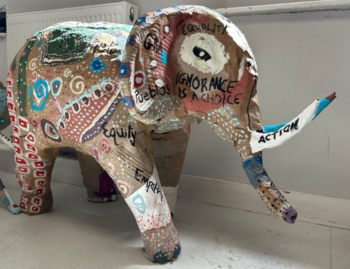
Interactive Art Installation
Participants will contribute to creating papier-mâché elephants under Tom Campbell’s guidance. These symbolic elephants will serve as a medium for collecting anonymous stories, experiences, and thoughts related to racism on campus.
Facilitated Discussions
Focus group conversations will accompany the art-making process, which are structured around a set of questions to encourage deep and meaningful dialogue.
Digital and Physical Exhibition
The completed elephants will be displayed at different locations in the University College Cork. People will be encouraged to deposit written messages about their ideas and experiences related to racism in the elephants. In addition, the project is slated to be unveiled on the website, serving as a focal point for continued discussion and engagement.
The project will also focus on investigating a range of research topics pertaining to racism. They are the role of education in combating racism, the impact of technology and social media on racism, the mental health implications of racism, and current anti-racism movements. Moreover, the project will explore various theoretical frameworks, such as decolonial perspectives, psychological theories of prejudice and stereotyping, and critical race theory. They will help to gain a deeper understanding of racism and its complexities.
Overall, the “Elephant in the Room” project represents a powerful and innovative approach to addressing a sensitive and often-overlooked topic. It combines art, community engagement, open dialogue, and rigorous research to create lasting impact and promote positive change within the college environment. This project could have a significant impact by raising awareness and encouraging discussions about the topic in question. Ying Chen.
Background
The Impact of Racism on Mental Health
Global Citizenship Development Education (GCDE) emphasises the interconnectedness of individuals and societies on a global scale, promoting understanding, empathy, and action towards addressing social justice issues such as racism. Racism undermines the principles of global citizenship by perpetuating inequality and marginalisation based on race and ethnicity. The consequences of racism on mental health are profound and multifaceted, affecting individuals, communities, and societies worldwide. At the individual level, experiences of racism can lead to psychological distress, including anxiety, depression, and other trauma-related disorders. Constant exposure to discrimination and prejudice can erode self-esteem and sense of belonging, leading to feelings of isolation and alienation. Internalised racism can lead to profound psychological distress, as individuals absorb negative societal messages about their own race, resulting in lowered self-esteem and identity conflicts.
Minority communities often face disproportionate levels of poverty, violence, and lack of access to resources, all of which contribute to heightened stress and lower quality of life. From a societal perspective, the impact of racism on mental health extends to broader systems of oppression and injustice. Inequities in healthcare, education, employment, and criminal justice perpetuate cycles of disadvantage and discrimination, disproportionately affecting racial and ethnic minorities. These disparities undermine efforts to achieve the 2030 Sustainable Development Goals, such as the eradication of poverty, promotion of quality education and ensuring good health and well-being. Racism also erodes social cohesion, trust, and solidarity, which are essential for fostering collective action necessary to address larger global challenges such as climate change and poverty. Therefore, combating racism and promoting racial equality are integral to advancing sustainable development and building a more just and equitable world for all.
Investigation into racism in Ireland, as evidenced by data from iReport.ie, reveals the profound repercussions it inflicts on individuals and society as a whole. Victims of racism endure not only physical and psychological harm, but also face disruptions in their professional lives, financial stability, and social connections. This underscores the urgent need for institutions to fulfil their duty in safeguarding human and civil rights outlined by the law. In the 2022 Reports of Racism in Ireland, 90% of people who reported a racist incident included information about the negative psychological impact it had on them. This is a shocking statistic that must be taken seriously as mental health disorders can significantly impair one’s ability to function in daily life. Left untreated, they have the potential to exacerbate into more severe conditions, increasing the risk of self-harm or suicide. A comprehensive approach is needed from institutions to address racism, including strict adherence to legal standards and proactive efforts to promote inclusivity and diversity. By taking action, Ireland can strive towards a more equitable and inclusive society where racism has no place.
In July 2013, INAR launched the iReport ‘Racist Incident Reporting System’ to capture details about racist incidents, the impact on the victim and witnesses, and the interplay with age, gender, sexuality and disability. If you would like to report an incident, it can be done through the iReport website. This is also a great resource to investigate how you can become actively anti-racist. Ellen Pereira.
Current efforts of anti-racism movements
The Black lives matter movement began in response to the systemic racism, police brutality, and racial inequalities that Black communities have historically faced and continue to face. Black Lives Matter has grown to influence a wide array of sectors, including the arts, media, and entertainment, leading to increased representation of Black individuals and narratives that reflect the Black experience. This cultural shift has expanded perspectives and fostered a greater appreciation for the diversity of Black life and its contributions to society.
The movement ignited in 2013 following the acquittal of George Zimmerman in the shooting death of Trayvon Martin. This verdict sparked outrage and protests, highlighting the racial injustices that are still prevalent in modern American society. Over the next few years, the deaths of Michael Brown in Ferguson and Eric Garner in New York, among others, at the hands of police, further fuelled the movement. These events highlighted the urgent need for reform and accountability in law enforcement and brought to the forefront the conversation about racial disparities in the justice system. In 2020, the killing of George Floyd, a Black man, by a Minneapolis police officer who knelt on his neck for over nine minutes, was captured on video and seen around the world. Floyd’s repeated cries of “I can’t breathe” became a rallying cry for an even broader global movement demanding an end to police brutality and systemic racism.
The movement advocates for transparency and accountability in law enforcement, which has historically inflicted disproportionate harm on Black communities. This advocacy extends to confronting systemic racism broadly, pushing for policies that foster racial justice. The urgency of these goals is underscored by alarming statistics and reports indicating that Black individuals are more likely to experience excessive force from law enforcement compared to their white counterparts. Additionally, the racial disparities evident in the justice system are stark, with Black individuals facing harsher sentences, higher incarceration rates, and generally unequal treatment.
Community Empowerment and Systemic Inequalities
Beyond policing, systemic racism permeates various aspects of life, creating significant barriers in education, housing, healthcare, and employment for Black individuals. The Black Lives Matter movement aims to empower Black communities to amplify their voices and demand equality effectively. This empowerment is critical as it supports the community in challenging and overcoming these pervasive inequalities.
Activism and Impact of the Movement
The activism strategies of the Black Lives Matter movement are diverse, including peaceful demonstrations such as marches, rallies, and vigils that raise awareness and apply pressure for systemic change. The movement also embraces civil disobedience—through sit-ins, blockades, and other non-violent resistance methods—to challenge the status quo actively. Furthermore, online activism plays a crucial role, leveraging social media campaigns, viral hashtags, and digital organizing to amplify the movement’s message and coordinate collective actions.
Allyship and Supporting the Movement
Supporting the Black Lives Matter movement involves several committed actions. Educating oneself about the history, goals, and experiences of the Black community is foundational. Allies are encouraged to use their voices and privileges to challenge systemic racism and advocate for meaningful change. This includes amplifying the perspectives and leadership of Black individuals and organizations, thereby contributing to a broader understanding and appreciation of their struggles and triumphs. Commitment to this cause is vital, recognizing that the fight for racial equity is an ongoing and dynamic process. Siwar Adhibi.
The Impact of Technology and Social Media on Racism
Technology and social media have transformed how societies interact, communicate, and confront issues, including racism. The relationship between technology, social media, and racial discourse is complex and multidimensional. This phenomenon significantly impacts both the dissemination and the mitigation of racism in current society.
The Positive Aspects of Technology and Social Media for Anti-Racism
Social media platforms have given a voice to marginalized groups and individuals who have historically been underrepresented or silenced. In particular, platforms like Twitter have emerged as critical spaces for discussing issues of race and racism. The use of Hashtags such as #BlackLivesMatter, #WhiteLivesMatter, and #AllLivesMatter not only facilitates communication but also serves as a means of mobilizing social and political movements. Through these platforms, the voices of marginalized communities can be amplified, promoting greater awareness and advocacy efforts against systemic racism (Afolabi and Holder, 2021). It means they can share their experiences, perspectives, and advocate for change, raising awareness about racism and its impacts.
Furthermore, social media has proven to be a significant tool for organizing and mobilizing movements, especially those aimed at addressing and combating racism. The capacity of social media to amplify voices and unite individuals towards a common goal has been powerfully demonstrated in movements such as Black Lives Matter (BLM), which have effectively leveraged platforms like Twitter to expand their reach and influence. This role of social media is critical in engaging a diverse audience and encouraging participation, which is crucial for maintaining these movements and creating lasting social change (Anderson et al., 2018). However, it’s also noted that while social media can foster significant social engagement, it also comes with challenges.
The Negative Aspects of Technology and Social Media for Anti-Racism
Research has shown that social media platforms can potentially amplify the diffusion of hate speech and discriminatory content. Maxwell (2016) suggests that social media platforms contribute significantly to reshaping racist dynamics through their design, algorithms, and corporate decisions. Many online platforms have become a breeding ground for hateful and discriminatory language. This includes the use of covert tactics, such as weaponized memes and fake identities, to incite racist sentiments. Sites like Reddit, YouTube, and Twitter have fostered toxic subcultures and networks of individuals who promote racist ideology. Twitter, in particular, has been called out for enabling coordinated harassment.
Another significant issue is the use of autocomplete features and algorithmic recommendations that make finding hateful content very easy, which is leading users towards more extreme views and communities . Social media platforms, such as Facebook, Twitter, Snapchat, Instagram, and TikTok, enable anonymity for harassers and algorithmically suggest racist content, which contributes significantly to the amplification of hate speech online (Matamoros-Fernández and Farkas, 2021). Overall, the evidence supports the idea that while social media offers unique tools for activism and engagement, its effectiveness and impact can vary based on how it’s used and the societal context within which it operates. Ying Chen.
The role of education in combating racism
There is a consensus that “systemic racism and discrimination are rooted in the structure of society itself, in governments, the workplace, courts, police and education institutions”,[1] and that education should help combating racism in society. Cecilia Barbieri, UNESCO’s Chief of Section of Global Citizenship, and Martha K. Ferede, Project Office in the same UNESCO office, identify the following problems as ‘the malignancy of racism’:
- school disciplinary policies disproportionately impact Black students,
- teachers’ expectations differ by students’ race,
- students from ethnic and racial minority groups are more likely to be labelled ‘at risk’ (they are identified ad students with social maladjustments or learning difficulties, hence placed in separate classes),
- education attendance and attainment correlate with race,
- racial discrimination takes places among students, and
- the returns to education differ by race.[2]
At the same time, they suggest that racism can be eliminated through:
- training and recruiting teachers that reflected the diversity of students,
- examining the curriculum from multiple vantage points (especially indigenous peoples forms of knowledge), and
- addressing implicit ideas bias.[3]
Institutional policies usually address the first and third Barbieri and Ferede’s suggestions, but not the second one, related to the curricula., which still exclusively promote Western knowledge as the one valid and legit. By doing that, the whole educational system is reproducing and perpetuating the most false and dangerous colonial legacy that is the root of racism: there is a culture that is superior to other, because peoples that owns that culture are superior to others.
While some countries, have been implementing ‘intercultural education’ to address some of the barriers that indigenous peoples or other ethnic minorities have within education, in practice, that concept is far from addressing the main curricula problem, which is the lack of cultural diversity. None of indigenous epistemologies, knowledges and worldviews are included, far less in higher education. Nevertheless, now there are some institutional policies that can be used as the basis and framework to advocate for a change. This is the case of the Higher Education Authority of Ireland (HEA), who has adopted a Plan to address race equality for 2022-2024.
For that Plan, the HEA has adopted the following definition of racism:
… the power dynamics present in those structural and institutional arrangements, practices, policies and cultural norms, which have the effect of excluding or discriminating against individuals or groups, based on their identity, as outlined in Article 1 of the International Convention for the Elimination of Racial Discrimination (ICERD), which provides: ‘…the term “racial discrimination” shall mean any distinction, exclusion, restriction or preference based on race, colour, descent, or national or ethnic origin which has the purpose or effect of nullifying or impairing the recognition, enjoyment or exercise, on an equal footing, of human rights and fundamental freedoms in the political, economic, social, cultural or any other field of public life.[4]
In that plan, to address the goal ‘Fostering diversity in HEIs’, they have recommended: ‘Developing university strategies to engage diverse views, such as decolonising/diversifying curriculum to Euro-centric viewpoints’. María Torres.
References – Research
[1] Barbieri, Cecilia and Ferede, Martha K, “A future we can all live with: How education can address and eradicate racism. [29 June 2020] UNESCO, available https://www.unesco.org/en/articles/future-we-can-all-live-how-education-can-address-and-eradicate-racism (date accessed: 26 April 2024).
[2] Ibid.
[3] Ibid.
[4] Higher Education Authority of Ireland (HEA), “Race Equality in the Higher Education Sector. Implementation Plan 2022-2024”, available https://hea.ie/assets/uploads/2022/03/HEA-Race-Equality-Implementation-Plan-2022-2024.pdf (date accessed: 05 April 2024), p.3.
Theoretical frameworks
Theories of Social Change in addressing Racism
Racism is a systemic issue ingrained within societies worldwide that continues to perpetuate injustice and inequality. Effecting change demands a multifaceted approach, one that incorporates various theories and practices of social change. Understanding these theories can provide insight into the mechanisms through which racism can be challenged and dismantled.
The Critical Race Theory (CRT) serves as a powerful lens through which to understand the intricate workings of racism within societies. It was developed in the 1970s and 1980s by legal scholars like Derrick Bell, Kimberlé Crenshaw, and Richard Delgado as a response to the limitations of traditional civil rights approaches in addressing systemic racism. It contends that racism is not merely a collection of individual prejudices or acts of discrimination, but is deeply ingrained within the fabric of society, embedded in institutions, laws, and everyday practices. It examines how power dynamics, privilege, and historical legacies contribute to the perpetuation of racism. One of the central concepts in CRT is interest convergence, which posits that advances in racial justice are often made when they align with the interests of the dominant group. This idea describes the limitations of legal reforms in challenging systemic racism, as they are often contingent upon those in power. CRT also challenges the myth of meritocracy, by exposing how supposedly neutral criteria for success, such as standardised testing or hiring practices, are often biased in favour of dominant groups. By revealing the ways in which meritocracy perpetuates racial inequality, CRT advocates for alternative models of evaluation that take into account the structural barriers faced by marginalised communities, which would be interesting for education institutes to explore further.
Community organising involves use of grassroots efforts to effect social change from the ground up. Grassroots movements use collective action at the local level to implement change in society, providing a basis for political or economic movements and empowers communities to address issues of concern collectively. In combating racism, community organising fosters solidarity, amplifies marginalised voices, and challenges oppressive structures at the local level. By building networks of support and advocating for policy reforms, grassroots movements can create lasting change within communities affected by racial injustice. This framework could be implemented within higher level institutions such as UCC, underpinning a student-staff collaborative grassroot movement which aims to eradicate all forms of racism within the University
Education plays a crucial role in challenging and dismantling racist ideologies. Anti-racism education seeks to raise awareness about the historical roots of racism, privilege, and systemic inequalities. It encourages critical thinking, empathy, and active engagement in addressing racial injustice. By incorporating diverse perspectives into curriculum and fostering open dialogue, anti-racism education equips individuals with the knowledge and skills necessary to confront racism in their personal and professional lives. The anti-racism workshop class, held as part of this GDCE course, is a perfect example of how to educate students in UCC. It’s meaningful and interactive nature has left a lasting impact, which all students could benefit and learn from.
Policy advocacy involves lobbying for legislative changes that promote racial equity and social justice. This approach aims to reform existing laws and institutions to address systemic racism. Policy advocacy efforts may include lobbying for police reform, voting rights legislation, or affirmative action policies. By influencing public policy, advocates can create structural changes that have a broad impact on addressing racial disparities and promoting equality.
UCC holds an ‘Equal Opportunities and Diversity Policy’, with guidelines that protect students and staff without discrimination on grounds of race. In July 2023, UCC signed the anti-racism principles set out by the Higher Education Authority as part of their work on ‘Race Equality within Higher Education Institutions’. As part of this, the HEA have provided 3 documents for use by institutions of higher education such as UCC including:
- Race Equality in the higher Education Sector
- Higher education authority Race equality Implementation Plan 2022-2024
- Anti-Racism Principles for Irish Higher Education Institutions
This is a really positive action taken by the University, however more needs to be done to prevent racism and have systems in place to help students and staff when they face racism. Ellen Pereira.
The Economics of Racism and Inequality
By examining the historical roots and economic outcomes of systemic racism, as well as the societal costs it incurs, we can pave the way towards more informed policies and underscore the importance of diversity and inclusion in fostering a more equitable future.
The history of systemic racism in the United States is long and troubling, dating back to the eras of slavery and Jim Crow laws. These periods were defined by severe exploitation, segregation, and the outright denial of economic opportunities to people of colour. The legacy of these times, reinforced by subsequent discriminatory practices like redlining and restrictive covenants, perpetuated racial segregation and economic disparities long after slavery was abolished.
Discrimination remains prevalent in various economic sectors today. For example, the job market still shows bias against individuals with “Black-sounding” names, who are less likely to receive job call-backs despite having qualifications identical to their white counterparts. This hiring discrimination significantly restricts economic opportunities and contributes to the persistent racial wealth gap. Furthermore, Black and Hispanic individuals often encounter greater challenges in accessing credit, loans, and other financial services, which stifles their ability to start businesses, buy homes, and build wealth. Additionally, systemic racism within the education system often results in fewer resources for schools in low-income communities and pervasive implicit biases, creating substantial barriers to educational attainment for students of colour.
The consequences of the racial wealth gap are profound and multifaceted. This gap primarily stems from historical inequities in wealth accumulation and transfer. White families have historically had more opportunities to accumulate wealth and pass it down through generations, whereas communities of colour have faced systemic barriers that hinder their ability to do the same. Homeownership, a key driver of wealth accumulation, exhibits significant disparities with much lower rates among Black and Hispanic families, a direct result of discriminatory housing policies. This lack of access to capital makes it difficult for people of colour to start and grow businesses, further exacerbating the wealth gap and limiting economic mobility.
The societal costs of inequality are significant. High levels of inequality can lead to slower economic growth as they limit the pool of talent and skills that can be fully utilized. It also reduces overall consumer demand and productivity. Economically marginalized groups, increasingly frustrated with systemic unfairness and lack of advancement opportunities, may contribute to heightened social and political instability. Inequality is also linked with poorer health and educational outcomes, as those with fewer resources have less access to quality healthcare and schools, perpetuating cycles of disadvantage.
Addressing economic inequity requires targeted investments in underserved communities, inclusive policies that promote fair hiring practices, and wealth-building initiatives that support homeownership and entrepreneurship among communities of colour. These efforts can help mitigate the legacies of discrimination and open up new economic opportunities.
Finally, the business case for diversity and inclusion is compelling. A diverse workforce brings a range of perspectives, experiences, and ideas, leading to more innovative problem-solving and better decision-making. Companies that prioritize diversity are more likely to attract and retain top talent, enhancing their competitive edge in the market. Siwar Adhibi.
Psychological Theories of Prejudice and Stereotyping
Prejudice and stereotyping are significant phenomena that affect many aspects of human social interaction. Gaining an understanding of the psychological mechanisms that underline these behaviours is critical in combating the biases that affect interpersonal relations and societal dynamics. This framework explores the evolution of various theories correlated to human behaviour and cognition from early psychological approaches to modern socio-cultural perspectives. The analysis highlights how our understanding has shifted towards more complex interpretations.
Definitions of Key Terms
Prejudice is defined as a collection of hostile or negative attitudes directed towards a particular group, solely on the basis of their membership in that group. Such attitudes may lead to discrimination if acted upon, which in turn perpetuates inequality and social tension (Bobo & Fox, 2003).
Stereotyping Involves attributing specific traits or expected behaviours to all members of a group, regardless of the actual diversity within the group. While this practice facilitates social interaction, it can lead to inaccurate and often harmful judgments. (Bobo & Fox, 2003).
Evolution of Theoretical Perspectives
1. Historical Perspectives and Early Theories
During the early 20th century, prejudice and stereotyping were commonly viewed through a biological lens, which posited inherent differences among races. These theories were often used to justify social hierarchies by naturalizing racial differences, which in turn reinforced discriminatory practices (Echabe, 1997). Such ideologies were prevalent among scholars, scientists, and policymakers, and played a significant role in shaping public discourse around race and ethnicity for much of the 20th century. However, in recent decades, advances in social and biological sciences have challenged these views, highlighting the social and cultural factors that contribute to the formation and perpetuation of prejudice and stereotypes.
2. Psychodynamic and Authoritarian Personality Theories
By the mid-20th century, the focus shifted towards psychodynamic theories, notably through the concept of the “Authoritarian Personality This theoretical framework posited that prejudice was rooted in inflexible personality traits and displacement mechanisms, where unacceptable impulses were redirected towards socially acceptable targets (Bobo & Fox, 2003) . This approach was seen as a significant departure from earlier theories of prejudice, which had focused more on social and cultural factors as drivers of discriminatory attitudes and behaviors.
3. Socio-Psychological Theories
In the latter half of the 20th century, theories started to emphasize the role of societal norms and cultural contexts in fostering prejudice. These theories argued that prejudice is a learned social norm, which is heavily influenced by the cultural and institutional settings that prevail during the socialization process (Echabe, 1997)
4. Modern Socio-Cultural Psychological Perspectives
Modern theories integrate psychological and socio-cultural aspects, viewing prejudice and stereotyping as phenomena that arise not only from individual attitudes but also from cultural and societal structures. This perspective highlights the influence of societal norms and cultural contexts on individual perceptions and behaviors, thus perpetuating racial prejudices in daily interactions (Salter et al., 2017).
Implications for Research and Practice
This understanding of prejudice and stereotyping, based on psychological theories, highlights the complexity of addressing these issues. Effective interventions must address both the psychological aspects of prejudice and the broader socio-cultural factors that sustain it. As a result, it is possible to develop more effective strategies for reducing prejudice and fostering a more inclusive society. Ying Chen.
Decolonial theories and Transmodernity
Decolonial studies are key when addressing historical and structural problems such as racism. As Gómez et al state, decolonial theories are epistemological and political commitments in response to the process of coloniality consolidated before and after the disassemble of colonisation.[1] Its main difference with postcolonial theories is that decolonial ones do not focus on a specific time (modernity) but rather challenges ‘coloniality of power’ regardless a time frame.[2]
For Aníbal Quijano, coloniality is one of the main constituent elements of capitalist power world pattern. Coloniality is based on the imposition of a racial/ethnical classification of world population as a cornerstone of that power pattern. Itoperates at every level, realm and dimension –physical and subjective– of everyday existence and social scale. Colonialityoriginated in, and has been globalized in, the United States of America.[3] Decolonial studies argue that the coloniality of power still shapes social, economic, and cultural hierarchies today. Hence, they try to dismantle power relationships and concepts of knowledge that promote the ongoing racial, geopolitical and gender hierarchies created in the modern/colonial world.[4]
In that sense, decolonial studies go beyond decolonisation and propose other type of alternatives to subvert hegemonic power and make visible the effects produced by colonisation and coloniality of power in the knowledge and in the being.[5] Under this framework, it is possible to imagine and propose other alternatives that can subvert coloniality. Enrique Dussel, for instance, suggested a transmodernity project to overcome the Euroethnocentric view of modernity and proposed what he called an epistemic pluriversity, where a dialogic and located knowledge, which recognises the needs of every collective, can be created from different perspectives.[6]
Upon the concept of Transmodernity, the construction of “the other” from an intercultural political practice is proposed, as well as the decolonisation of the (assumed to be) universal Western knowledge.[7] In this way, it would be possible to overcome the historical and systemic oppression which, as Espinosa-Miñoso asserts, is based on a system of knowledge and production of a specific worldview, a system of social sorting within which dominant categories (gender, race, class) have emerged.[8] María Torres.
References – Theories
[1] Gómez, Martha et al, “Estudios decoloniales y poscoloniales. Posturas acerca de la modernidad/colonialidad y el eurocentrismo” [2017] available https://www.redalyc.org/journal/5857/585761563002/html/#ref33 (date accessed: 05 April 2024)
[2] Ibid.
[3] Ibid.
[4] Ibid.
[5] Ibid.
[6] Ibid.
[7] Ibid.
[8] Ibid.
Action plan development and process
For this project, our group created a WhatsApp group to coordinate the organization of the workshop and the class presentation. We had two meetings as a group (one in person and one on-line), to clarify the objective and distributions of the tasks. The WhatsApp group worked perfect, and it was our main platform of communication, since the four of us are in different programs and have different timetables. We also had a preparatory meeting with Gertrude, our lecturer, to arrange the logistics (materials, the venue, participants, dynamic of the workshop). The vocal point between us and Gertrude was Ellen.
To make the elephants, we needed to get lots of newspapers and cardboards, which we knew would be a challenge. Fortunately, we overcome this situation with Gertrude’s support, who was able to get most of the newspaper we needed. The other main responsibility was to find people interested in participating in the workshop, especially in a week where the majority of students have many assignments to work on. At the end, there around 12 people for the first session, and 6 for the second session of the workshop.
For our class presentation, we all worked on a Canva format, but Ying was in charge of improving its design. We were able to work the Canva document online and had one in-person meeting to finalise last small details. Although, we couldn’t make the presentation in class, we did have the chance to invite our classmates to join us for the workshop.
Moreover, for the workshop discussion, each of us prepared two questions according to the background research and theoretical framework that we had chosen. Also, we knew that the workshop would last two days, and that the four of us would not be able to attend the whole time on both days. So, we decided to take turns and try to cover each other to secure that at least one of us would be always present at the workshop.
Overall, we worked this project as a team, collaborating and complementing each other, while sharing our views on racism and learning from each other’s experiences. Our different backgrounds (business, nutritional science, human rights & indigenous peoples) and different motivations to choose this assignment (understanding cultural diversity and its challenges within institutions and deepen the knowledge on how racism is being addressed by university’ policies) were definitely an asset to comprehend, in real life and within university, racism and anti-racism from different perspectives. María Torres.
Implementation of action
Our Action Campaign: The Elephant in the Room
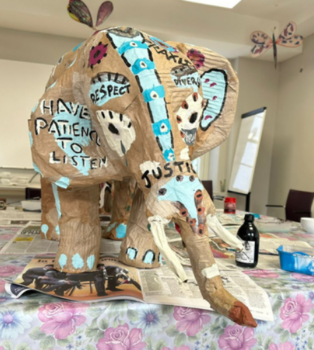 As a group, we hosted a creative workshop in Nano Nagle Place, open to both students and staff, forming part of a wider research project in UCC. Our aim was to use creative expression and community engagement, to create a safe space for sharing experiences, fostering understanding, and discussing solutions to combat racism. We worked with Tom Campbell, a Cork based artist, who has a passion for papier-mâché. We created papier-mâché elephants, representing the metaphor of the ‘elephant in the room’, while staff and students engaged in a conversation discussing their experiences and perceptions of racism and anti-racism, specifically within UCC. These conversations were enabled by questions we had come up with as a group prior to the workshop. Some of which included:
As a group, we hosted a creative workshop in Nano Nagle Place, open to both students and staff, forming part of a wider research project in UCC. Our aim was to use creative expression and community engagement, to create a safe space for sharing experiences, fostering understanding, and discussing solutions to combat racism. We worked with Tom Campbell, a Cork based artist, who has a passion for papier-mâché. We created papier-mâché elephants, representing the metaphor of the ‘elephant in the room’, while staff and students engaged in a conversation discussing their experiences and perceptions of racism and anti-racism, specifically within UCC. These conversations were enabled by questions we had come up with as a group prior to the workshop. Some of which included:
- What is your own understanding of anti-racism?
- Have you ever experienced, or witnessed racism within UCC?
- Have you implemented an anti-racist framework within your work in the University?
- How can we combat racism on UCC campus?
At different points throughout the day, we took a break from making the elephants, to ask a question to the group. Gertrude Cotter made initial notes of the responses, which can be seen below:
Key Themes Discussed
1. Systemic Accountability and Everyday Racism
- Building Bridges: Participant spoke about the importance of building bridges between diverse groups on campus to foster understanding and cooperation.
- Accountability: Participants highlighted the need for systems to be held accountable, not just in policy but in everyday practice, addressing the gap between written rules and daily experiences.
- Empowering Voices: Participants stressed empowering students and staff to have real voices in decision-making processes, not merely as tokenistic inclusivity but as genuine contributors to campus life.
2. Personal Experiences and Observations
- Integration Challenges: A participant shared feelings of isolation as the only friend of colour among Irish peers, pointing out the lack of integration of international students.
- Incidents of Racism: Participant recounted an unsettling incident where her husband was treated differently upon revealing his identity, highlighting the subtle everyday racism that can pervade social interactions.
- Unconscious Bias: The discussions included examples of unconscious bias, such as differential treatment based on names on emails, reflecting deeper systemic issues.
3. Initiatives and Responses
- Anti-Racism Frameworks: The university has implemented several frameworks such as the Race Equality Network and Anti-Racism Awareness Training. However, participants noted that these initiatives often don’t translate into practical action or clear guidelines on addressing racism when witnessed. They also need to be accompanied by deeper education and not just ‘policies on the shelf’.
- Policy and Practice: The gap between anti-racist policies and their implementation was a concern, with calls for more transparent and actionable steps to be outlined for those experiencing or witnessing racism.
4. Cultural Reflections and Education
- Educational Mission: The role of the university as an educational institution was discussed, with a focus on teaching students to confront societal issues, including racism, with adequate knowledge and tools.
- Curricular Reforms: Participants suggested a review of the curriculum to address colonial legacies and incorporate a more inclusive perspective that recognises the contributions of non-Western cultures.
5. Future Directions
- Long-term Change: The need for ongoing dialogue and long-term strategies to combat racism was emphasised. The placement of elephants around the campus with accompanying story boxes is intended to encourage continuous engagement and reflection on these issues.
- Community Engagement: By fostering a community dialogue through art and discussion, the project aims to make the issue of racism an unavoidable presence that demands acknowledgment and action.
Overall, “The Elephant in the Room” workshop was interesting and enjoyable method of research, that has initiated critical conversations about racism and anti-racism at our university. The use of creative arts for research purposes has not been done before within UCC and seemed to be a first for all the participants. We found it was difficult to begin conversations about racism while making the elephants due to the intensive physical process; however taking breaks for conversation then sparked further discussion between members during the making process. The use of art fostered a comfortable and energetic atmosphere, as we were working together for a common goal. It provided a focus to the workshop and made a serious topic of conversation a little easier to talk about. The project highlights the importance of not only recognising racism, but actively working towards an inclusive and equitable campus environment.
Thank you to Tom Campbell for his support in the making process and those who attended the workshop. Ellen Pereira.
Decoration of the Elephants
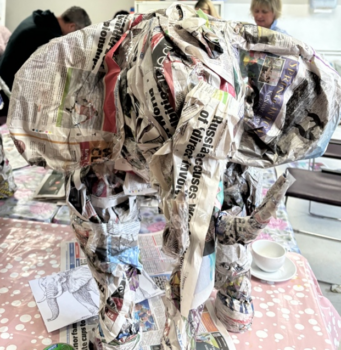 This initiative seeks to visually symbolize and prompt discussions on underrepresented issues. The “Elephant in the Room” project employs art to highlight significant but often ignored societal issues. The choice of the elephant serves as a metaphor for large, looming problems that are typically overlooked. This paper details the methodology employed in crafting and decorating these papier-mâché sculptures and outlines their strategic placement and role on campus.
This initiative seeks to visually symbolize and prompt discussions on underrepresented issues. The “Elephant in the Room” project employs art to highlight significant but often ignored societal issues. The choice of the elephant serves as a metaphor for large, looming problems that are typically overlooked. This paper details the methodology employed in crafting and decorating these papier-mâché sculptures and outlines their strategic placement and role on campus.
The painting of the papier-mâché elephants was conceptualized as an open canvas approach, allowing each of us the freedom to contribute creatively in a manner that reflects both personal aesthetics and collective vision.
While we engaged in the creative process of decorating the papier-mâché elephants, conversations about racism spontaneously emerged. As the we worked on adding visual elements that highlighted issues of racism, many found it a suitable moment to share personal experiences and thoughts. This sharing occurred casually among us, creating an open and honest dialogue. Some participants shared personal stories of encountering racism, which were met with empathy and support from the group.
The process was inherently collaborative, we were encouraged to add personal touches. This phase was less about following a prescribed design and more about allowing spontaneous creativity to flourish. Brushes of various sizes were available, enabling detailed work such as intricate patterns, as well as broader strokes. In this creative free-for-all, some chose to draw inspiration from traditional motifs, painting floral patterns or geometric designs, while others opted for abstract expressions. The key was in the layering of paint, where the deliberate choice to allow the brown paper base to peek through not only paid homage to the raw material but also added depth and texture to the artwork. During the detailing phase, we added more than just artistic designs; we also incorporated significant phrases in different languages, important dates, and messages addressing the theme of racism. These elements were painted in black to stand out against the vibrant backgrounds, ensuring they were easily readable and visually impactful. As one person chose a phrase or date to paint, they might explain its significance, sparking interest and curiosity among us.
The elephants will be strategically positioned in key areas around the campus such as the library, student union, and other buildings in other to maximize visibility and interaction. Each installation will invite people to reflect on the issues of racism, sparking dialogue and encouraging a deeper engagement with the project’s themes. They are asked to leave a note with their experience, feelings or ideas towards anti-racism in the box provided beside the elephant.
Reflections and future steps
Ellen Pereira
This module, through both the weekly classes and project work, has facilitated the development of skills such as initiative, teamwork, and leadership through its student-led approach. It has successfully emphasised the importance of taking action to change local and global issues and allowed this learning to be put into practice. The ‘Elephant in the Room’ workshop was an inspiring experience, that has opened my eyes to the complexities of racism and the importance of fostering both dialogue and community engagement to address the issue. The workshop provided a unique platform for creative expression and meaningful conversation, allowing me to explore and learn from experiences and ideas surrounding anti-racism within our university community.
I thoroughly enjoyed the use of creative arts as a method of research and although not naturally artistically gifted, I found the process therapeutic and enjoyable. The clear guidance from Tom and working in groups made the making process much easier. Working together to create these elephants fostered a sense of unity and purpose among us all, as we engaged in both artistic expression and critical dialogue. Despite the physical intensity of the papier-mâché process, we did find moments to discuss our prepared questions. These conversations were enlightening and for me, sparking a deeper understanding of the complexities of racism and the need for collective action within the University. Due to time constraints, I feel as though we did not get to explore the topic as much as we had hoped, scratching the surface. Perhaps next time a more structured session, with longer breaks for conversation would be beneficial for research findings.
One of the most significant insights gained from the workshop was the recognition of the gap between anti-racist policies and their implementation in practice within the university. While UCC has implemented various frameworks and initiatives to address racism, I along with other participants felt frustration with the lack of tangible action and guidelines for addressing racism when experienced or witnessed. This discrepancy emphasises the need to translate current university policies into meaningful action, a responsibility that higher level institutions should be held accountable for. Further research and action should be carried out to investigate how to actively implement a change. The workshop also highlighted the power of community engagement and creative expression in addressing sensitive issues such as racism. By fostering a safe space for dialogue through art and discussion, the project brought together strangers who felt they could open up about personal experiences and opinions; without the creative outlet, this may not have been so easy.
Overall, the ‘Elephant in the Room’ workshop was a thought-provoking and inspiring experience that put me out of my comfort zone and allowed me to learn from others’ ideas towards positive change. The use of creative expression in social activism has left me feeling empowered to work towards social justice. As I continue my journey towards global citizenship, the lessons learned from this workshop will serve as a reminder of the importance of actively working towards a more just and equitable world for all. It has given me confidence in my ability to articulate opinions and lead conversation.
Siwar Adhibi
The “Elephant in the Room” papier-mâché project was a key part of my learning as an international business student. It blended art with discussions about cultural diversity and business impact on society, teaching me a lot. The project used art to start conversations about racism, which caught my attention because it ties into my interest in how social issues impact businesses worldwide.
I also got to apply business concepts creatively. For example, we thought of placing the elephants in high-traffic areas on campus, similar to how businesses use marketing to draw in customers. The messages on the elephants shows the importance of clear and effective communication in reaching people. Part of each elephant was left unpainted to show the raw material underneath, symbolizing the need for transparency and authenticity in communication, much like in ethical business practices.
Working with a diverse group of students was also very rewarding. Everyone brought different cultural perspectives and creative ideas, which made our team dynamic and a great learning environment. This project was not just about learning from others but also about building new friendships and understanding more about inclusion.
This project and the course have been transformative for me, deepening my understanding of global issues and preparing me to help make changes. I’m grateful for the new connections and growth opportunities it brought.
María Torres
The Elephant in the room project helped understand how art can be a useful tool not only to comprehend experiences on racism, but to create spaces of hope for communities. It also allowed me to get some real-life insights for my LLM dissertation on human rights, which is focused on the right to an intercultural higher education and its relationships with indigenous peoples’ rights, such as self-determination, equity, and ethnic identity.
As discussed in the workshop, racism within higher education is an old phenomenon, and the big question is why it is still present despite the anti-racism efforts made by the Government and universities. Before the workshop, and because of my previous research, I had so many concerns regarding institutional racism reflected in the curricula, and after sharing my thoughts with the participants, I can say that, even though those concerns are still present, I feel I no longer carry them alone.
And I think that one of the achievements of projects like this one, that seek to discuss sensitive topics such as racism in a community, is that people involved can find a safe place not only to express their experiences, feelings, and emotions, but also to be able to validate their thoughts and concerns, not feeling lonely anymore in this journey. Art played a huge role here, since allowed us to step out from our rational and ‘grown up’ minds and interact with each other as kids do in kinder garden, with curiosity, open minds, feeling relaxed doing ‘simple’ things, such as folding newspaper, getting our hands in glue and painting colourful elephants. At a certain extent, it can have healing effects on the participants.
From my point of view, I could see and feel two kinds of vibes in the room while working in the elephants. The first one was the concern and anguish produced by the participants’ testimonies and experiences on racism, while the other one was the feeling of solidarity and hope among us, knowing somehow that we are not alone in this struggle, and that we are building something, somehow, to change this sad reality. And I think that this type of dynamics, that goes beyond the typical seminars and written assignments are necessary in academia to address and change racist practices within the university. It is not enough for students and staff to know, but they need to feel, both grief and hope.
Ying Chen
Being a part of this anti-racism project has been such a joyful experience. Throughout this project, my understanding of the complex dynamics of racism and its counteractions has deepened significantly. The lectures I’ve had, the literature I’ve read, the collaboration with my team members, and the interactions with participants during our workshops have all contributed to a comprehensive learning experience that I’ll never forget.
The project allowed me to explore various aspects of anti-racism from multiple perspectives. So I personally focused on learning about the Impact of Technology and Social Media on Racism and the psychological aspects of prejudice and stereotyping. I choose these two because I feel that current technology and social media lead to extremely racist online behaviours, especially the recommendation mechanisms based on algorithmic technology. In addition, being a minority, I sometimes read about prejudice and stereotyping comments about a particular ethnic group. Even myself, I sometimes have stereotypes about some nationality. After researching both areas, I have developed an interest in learning more about them.
The project’s most interesting arrangement to me is the “Elephant in the Room” workshop. The workshops provided practical, real-world applications of our studies, where communication with participants highlighted the lived experiences of those affected by racism. Through my observation during the conversation in the workshop, I am very surprised that certain ethnic groups have to face more racism challenges in society, even on campus. I feel like this project helped me understand anti-racism in a more holistic way, integrating theory, research, and real-life dialogues. Furthermore, I discovered that the artistic process not only relaxed participants but also encouraged them to open up about their experiences and views. This creative avenue for expression is an effective medium for deep, meaningful conversations about race and identity. It allows participants to share personal stories and insights in a supportive and friendly environment.
Through my interactions and observations, I realize that prejudice and stereotyping still pervade our UCC campus. The fact that I hadn’t personally faced direct instances of racism doesn’t negate the experiences of others who have. I learned that some people don’t feel supported adequately, as the campus lacks clear guidelines and established rules to actively promote anti-racism. It makes me think about what I can do in the future.
Based on my previous experience on social media, I will keep doing study and research on the relationship between technology, social media and racism, enhancing my abilities to raise awareness about anti-racism. Also, I will engage with community organizations that focus on social justice and anti-racism and look for volunteer opportunities or support their initiatives that can have a profound impact.
Reflecting on this project, I am pleased to see I gain more in-depth understanding of anti-racism and how I can contribute to actively participate in creating a more inclusive and equitable community environment. I hope I will continue this learning journey in the future.
Summary
The “Elephant in the Room” project at University College Cork(UCC) successfully concluded its workshop phase, where participants engaged creatively to address and discuss racism within the college community. Under the guidance of artist Tom Campbell, four papier-mâché elephants were crafted and painted during the workshop. These elephants, which serve as the project’s core metaphor for confronting significant but often ignored issues, will be displayed at different locations on the UCC campus to stimulate ongoing dialogue and reflection on racism and anti-racism.
During the workshop, participants shared personal experiences with racism through structured discussions and art-making activities. This approach not only created a supportive environment for open dialogue but also enabled an anonymous collection of stories and thoughts about racism. The interactive art installation is more than just a display – it serves as a dynamic platform for ongoing engagement.
Following the workshop, the project plans to extend its impact through a digital and physical exhibition of the elephant artworks. Campus community members are encouraged to share their racial experiences and anti-racism ideas by depositing written messages into the elephants while they are being displayed on campus.
By blending art, community engagement, and academic research, the “Elephant in the Room” project aims to create lasting awareness foster change within the college environment and encourage deeper and continuous thinking about racial issues in the college community and beyond.
Photos
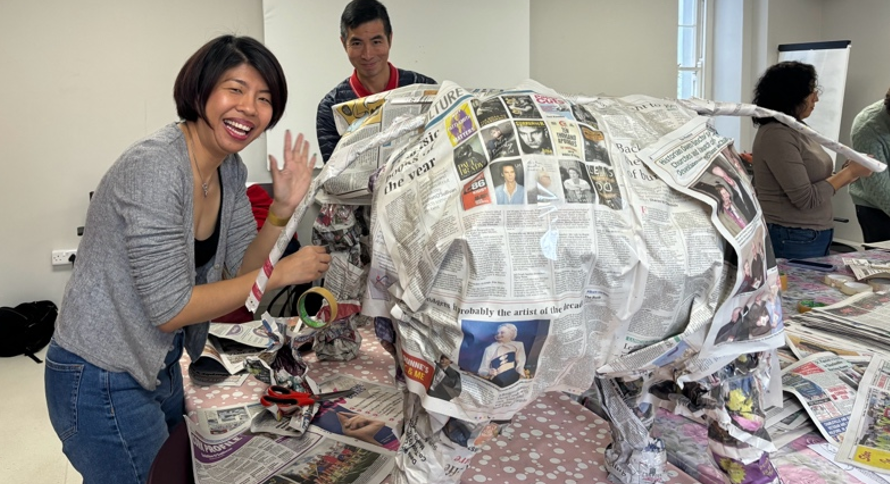
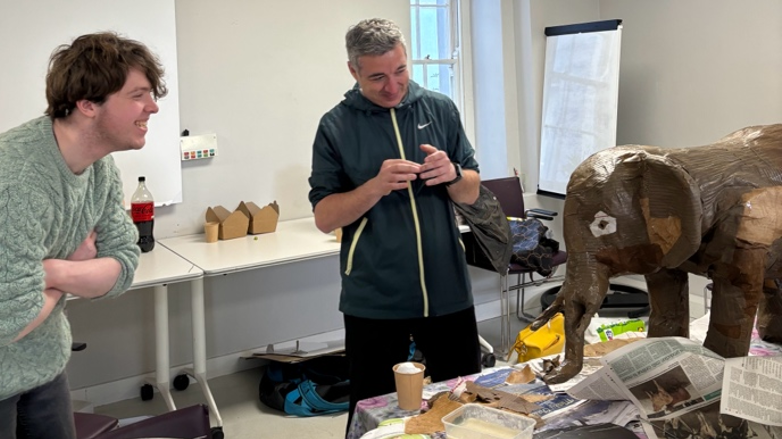
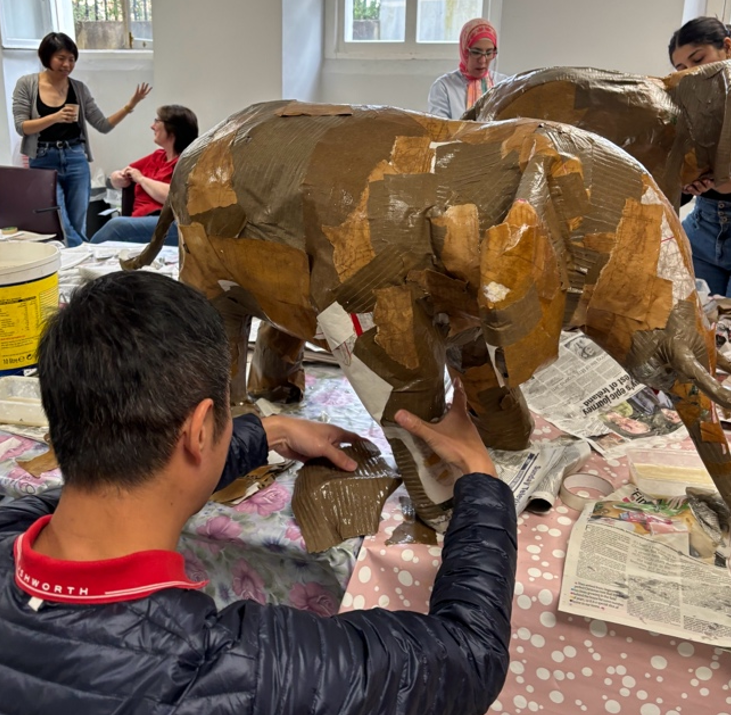
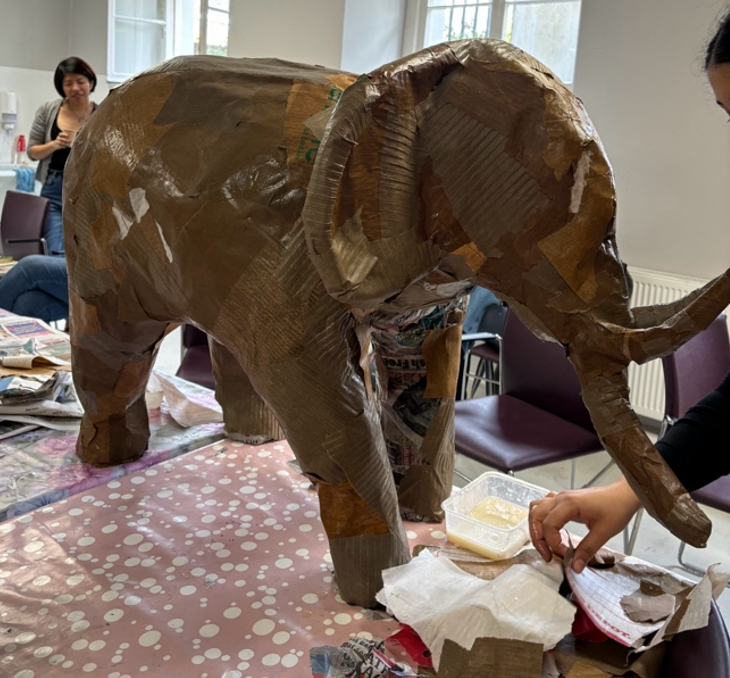
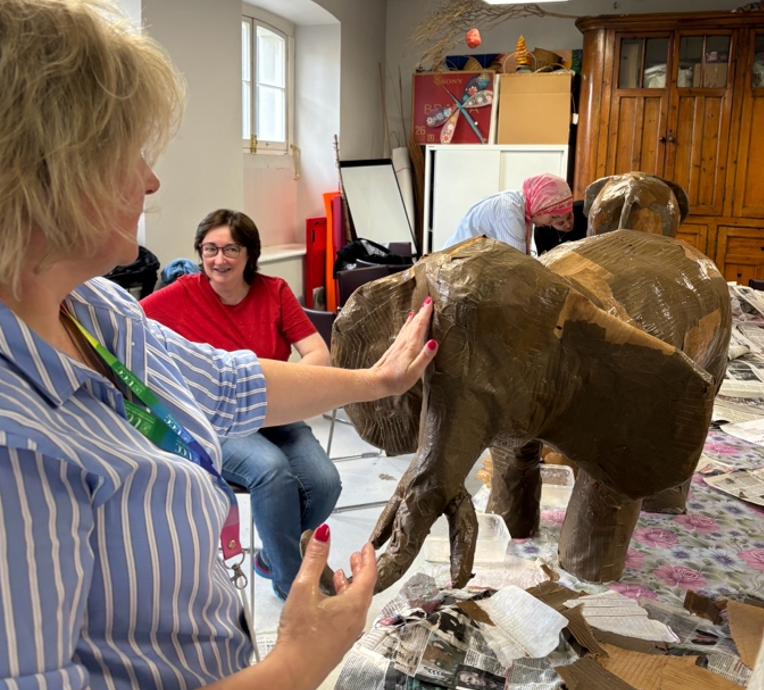
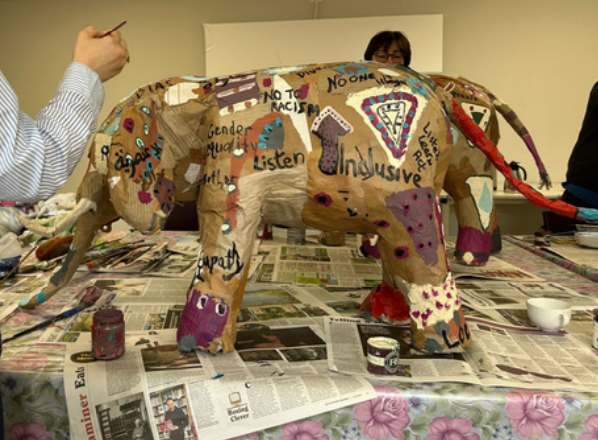
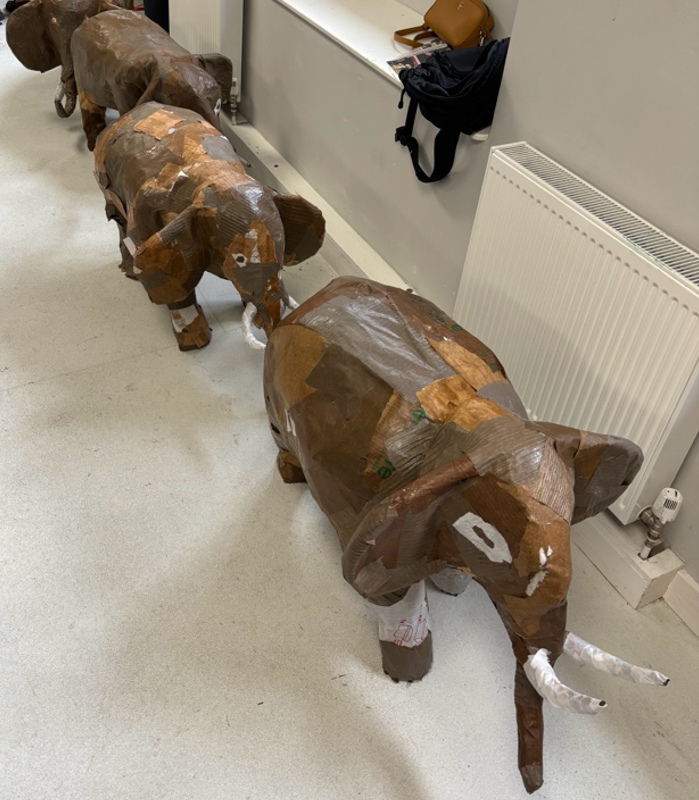
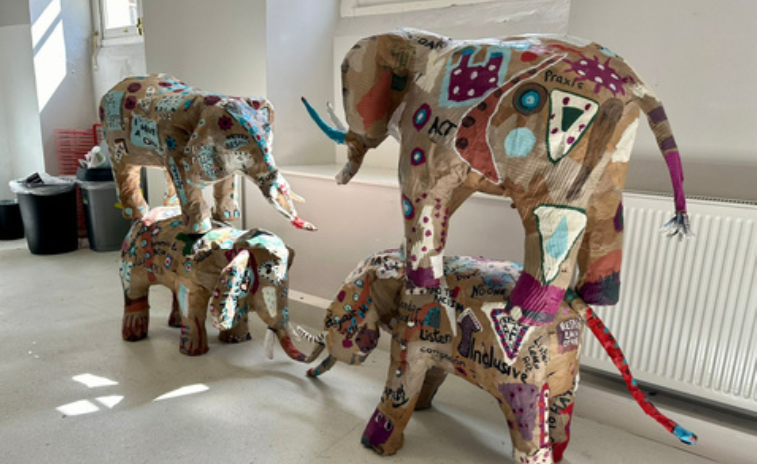
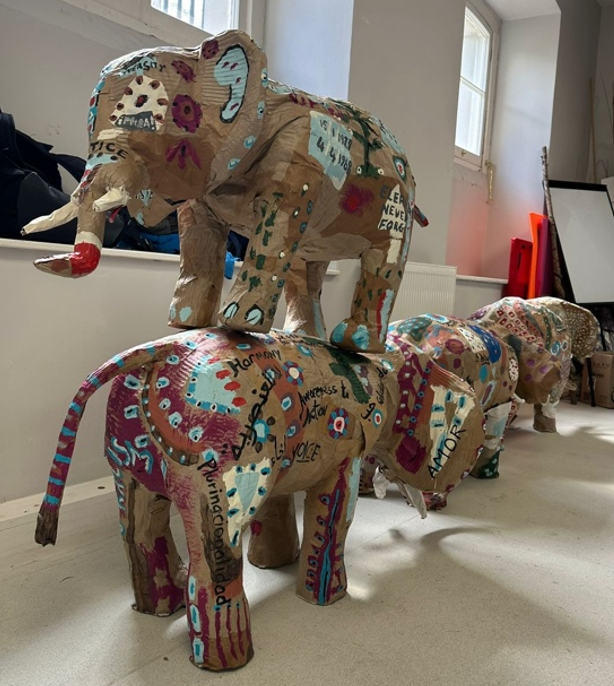

ELEPHANT
IN THE ROOM
Authors
Ellen Pereira; Ying Chen; Maria D’Jalma Torres Sanchez; Siwar Adhibi.
© 2024. All rights reserved. Praxis UCC.
